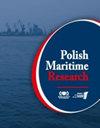Analysis of Model-Scale Open-Water Test Uncertainty
IF 2
3区 工程技术
Q2 ENGINEERING, MARINE
引用次数: 1
Abstract
Abstract Within the frame of CTO’s standard procedure, a propeller open-water test is preceded by a reference measurement, which is taken for a reference propeller model (P356). The results of these measurements are assembled to conduct an open-water test uncertainty analysis. Additional material was gathered from open-water tests that were conducted throughout several research projects on the CP469 model, which is a model of the Nawigator XXI propeller. The latter is a controllable pitch propeller; its pitch was reset before each test repetition. Known procedures for the determination of the open-water test uncertainty do not allow one to extract the manufacture impact directly, without building many models. This factor was addressed with the use of lifting surface calculations. Under certain additional assumptions, these calculations were performed for 100 generic versions of each propeller’s geometry, which were generated by random deviations from the theoretical data within the limits of allowed tolerances. The results of the conducted analyses made it possible to extract separate factors, which were connected to the test’s repeatability, measurement bias and geometry tolerance.模型开放水域试验不确定度分析
在CTO标准程序的框架内,螺旋桨开放水域试验之前要进行参考测量,该参考测量是对参考螺旋桨模型(P356)进行的。将这些测量结果集合起来进行开放水域试验的不确定度分析。额外的材料是从几个研究项目中对CP469模型进行的开放水域测试中收集的,CP469模型是navigator XXI螺旋桨的一个模型。后者为可调螺距螺旋桨;它的音高在每次重复测试之前被重置。已知的确定开放水域试验不确定度的程序不允许在不建立许多模型的情况下直接提取制造影响。利用提升面计算解决了这一因素。在某些额外的假设下,这些计算是对每个螺旋桨几何形状的100个通用版本进行的,这些版本是在允许的公差范围内由理论数据的随机偏差产生的。所进行的分析结果使提取与测试的可重复性、测量偏差和几何公差相关的单独因素成为可能。
本文章由计算机程序翻译,如有差异,请以英文原文为准。
求助全文
约1分钟内获得全文
求助全文
来源期刊

Polish Maritime Research
工程技术-工程:海洋
CiteScore
3.70
自引率
45.00%
发文量
20
审稿时长
>12 weeks
期刊介绍:
The scope of the journal covers selected issues related to all phases of product lifecycle and corresponding technologies for offshore floating and fixed structures and their components.
All researchers are invited to submit their original papers for peer review and publications related to methods of the design; production and manufacturing; maintenance and operational processes of such technical items as:
all types of vessels and their equipment,
fixed and floating offshore units and their components,
autonomous underwater vehicle (AUV) and remotely operated vehicle (ROV).
We welcome submissions from these fields in the following technical topics:
ship hydrodynamics: buoyancy and stability; ship resistance and propulsion, etc.,
structural integrity of ship and offshore unit structures: materials; welding; fatigue and fracture, etc.,
marine equipment: ship and offshore unit power plants: overboarding equipment; etc.
 求助内容:
求助内容: 应助结果提醒方式:
应助结果提醒方式:


